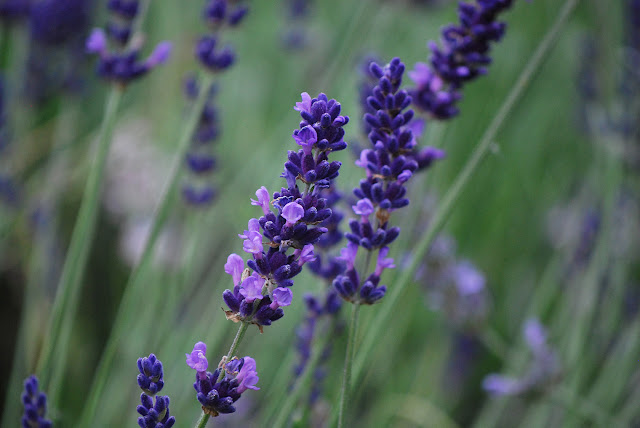LAVENDER: One of the Most Important Essential Oils for First Aid
We often think of lavender as an aroma used to reduce stress and improve overall well-being. This is definitely the case and our next Fragrant Friday will address those applications. Lavender is also one of the most valuable essential oils for a very wide of first aid needs. With summer still here we are going to focus on how lavender can by used for sunburn, bug bites, inflammatory conditions and all kinds of skin problems, many of which are exasperated by hot humid weather.
First some history.
 |
| Rene-Maurice Gattefosse |
In July 1910, the French chemist Rene-Maurice Gattefosse was involved in a laboratory explosion. Both hands were covered with gaseous gangrenous sores. He plunged his hands into a container of clear liquid, which immediately halted the gasification of tissue and caused him to sweat profusely. Healing began the next day. The mystery liquid was lavender essential oil. Gattefosse was so impressed with this experience that he used it for everything, documenting remarkable results in healing all kinds of wounds and sores.
One of the best uses for lavender essential oil (EO) is skin care. It can be used with just about any skin condition including cuts, scrapes, wounds, sores, warts, insect bites or stings, burns, scalds, pimples, boils and rashes. In addition to its cleansing and soothing effects, it can stop bleeding, prevent infection and help skin heal without scarring.
Lavender EO Recipes for First Aid and Skin Conditions
- To relieve sunburn, apply lavender EO neat and cover with a cool damp cloth. You can also add 4 to 6 drops of lavender EO to a packet (about ½ cup) of colloidal oats or ½ cup milk to tepid bath water to soothe sunburned skin. Adding 10 to 20 drops of Lavender EO in an ounce of aloe vera gel, aloe vera juice or yogurt can be applied as often as needed to sunburned skin.
- Alternating neat applications of lavender with ice can prevent minor burns from blistering.
- Lavender added to massage lotions or baths can reduce muscle and joint pain, inflammation, cramps or colic.
- 20-40 drops of lavender EO added to wheatgerm oil can prevent or reduce stretch marks.
- Lavender EO alone or combined with tea tree EO is effective for relieving mosquito bites. Resist scratching the bites, wash with warm soapy water and apply the EO, which can make itching and swelling disappear. If the bites do get scratched, the lavender/oat bath above can stop itching and heal the sores. This same bath is useful for healing and reducing the itch of chicken pox or prickly heat.
- Make soothing compresses to calm rashes by adding 5 drops of lavender EO to a bowl of cool water.
- To relieve heat exhaustion it is important to stay in the shade and drink as much water as possible; make a lavender compress as above and apply to the back of the neck, forehead and solar plexus.
- Lavender EO can be diffused to calm a sick person, reduce headache and fever, and disinfect the living space.
- For earaches, mix 6 drops of lavender EO in a teaspoon of extra virgin olive oil. Massage this mixture around the outer ear and down the side of the neck. Never use essential oils (diluted or neat) directly into the ear.
- 5 drops lavender EO with ½ cup vinegar in a sitz bath, or 2 to 4 drops lavender EO in a warm water douche can help relieve vaginal yeast infections.
- A few drops of lavender EO mixed with ½ cup Epsom salts in a warm foot bath can relieve fatigue or neuralgia.
Know your Lavenders!
Because there are several “lavenders” on the market, knowing the Latin binomial (botanical name) is very helpful for choosing the correct one for use in first aid.
The most soothing lavender EO is produced from Lavandula angustifolia. This lavender, called True Lavender (or Lavender vera), grows in the hot dry, rocky areas of the Mediterranean above 2000 feet, where exposure to more blue light produces a sweeter, powdery scent and more sedative and anti-inflammatory actions.
Spike Lavender (L. latifolia) has a higher yield than True Lavender, is easier to harvest since it grows at lower altitudes (below 1500 feet), and therefore produces a less expensive essential oil. Its scent is camphoraceous, and does not have the sedative and anti-inflammatory properties needed for first aid.
Lavandin (L. x intermedia) is a hybrid that grows where the other two varieties meet. Lavandin has the higher yield of Spike Lavender with similar properties of True Lavender. Lavandin is effective for skin, respiratory, muscular, and circulatory complaints.
Lavender EO should be in all first aid kits. It is easy to find, relatively inexpensive, and has a variety of uses. It is considered non-toxic, non-irritating, non-sensitizing, and blends well with most other essential oils. Lavender EO is one of the few that can be safely recommended for use neat, even for sensitive skin. Remember, however, that all essential oils are highly concentrated and should be treated with respect and caution. People with a family history of hay fever, asthma, eczema, or other skin reactions, may be allergic or sensitive.
©Vicki Rae Thorne, certified
aromatherapist and herbalist, has been formulating essential oil remedies since 1992. She founded Earth Heart
in 1996 to help others learn how to safely and effectively use herbs and
essential oils as part of everyday life. Vicki is a member of the American Herbalists Guild, the Alliance of International Aromatherapists,
and Women in the Pet Industry Network.


